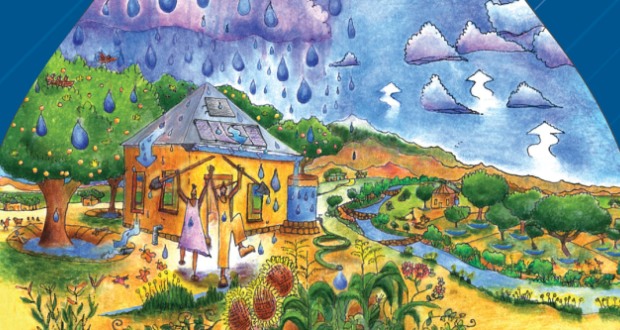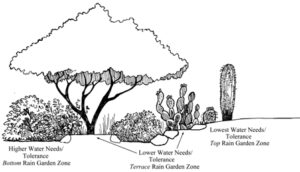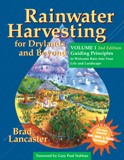Go With the Flow

By Brad Lancaster
We live amid natural abundance that can be made even more abundant just by using what we already have for free. If you can see it, you can plant and grow it.
Let’s begin with water. Even in my dry hometown of Tucson, Ariz., (and most other communities in the United States) in a year of average rainfall more rain falls on the surface area of the community than all its citizens consume of utility water in that same year. Nonetheless, 30 to 70 percent of the drinking water consumed by the typical American household is used to irrigate landscapes.
Rainwater is the best water for our plants and soil. It is free of the salts common in our groundwater and imported surface waters, which build up in irrigated soil and impede plants’ ability to photosynthesize and utilize water. Rainwater is a natural fertilizer, containing sulfur, beneficial microorganisms, mineral nutrients, and nitrogen. And it’s free.
Nonetheless, we drain the vast majority of that high-quality rainwater (along with precious topsoil and other sources of fertility picked up by the runoff) out of our communities almost as quickly as it arrives. This occurs via mound-like landscapes, soil scraped and raked bare, excessive paving, and our streets and storm drains. We then turn around and pay to import water from elsewhere. This further dehydrates us in dry times, increases flooding in wet times, and costs more money in all times. What are we thinking?
This unnaturally exposed soil and pavement, along with the sun-baked exterior walls of our homes, schools, and other buildings then drain still more water by absorbing the heat of the sun during the day and re-radiating that heat back out at night, increasing summer temperatures by up to 10 degrees Fahrenheit, which leads to another statistic that may shock you — but which can also empower you: In dryland communities, and during the dry seasons of wet-climate communities, more water is lost to evaporation than is gained by rainfall. For example, Tucson’s average annual rainwater income/gain is about 11 inches of rain a year. But its potential water loss to evaporation is about 100 inches per year. The more temperatures increase, the greater the evaporative loss.
Use this information to act, and enhance life with six steps:
- Improve your water gain by planting the rain before you plant any vegetation. (Or plant the rain beside vegetation if the plants are already in the ground.) Plant the rain within bowl-like — as opposed to mound-like — shapes in your landscape to capture and infiltrate, rather than drain, the rain.

- Plant your runoff. Emphasize the placement of these basin-shaped rain gardens next to and below impervious surfaces such as roofs, roads, and patios from which water runs off. That way you can double or even triple the available rainfall and flood-control potential in the basins by capturing both rainfall and runoff, which becomes runon, and that’s right on!
Note that the City of Tucson has passed an ordinance that all new city streets must be designed and built to harvest at least a half-inch rainstorm’s worth of water to freely irrigate street-side vegetation shading the street and walkways. This has reduced the costs of plumbing, water, and weeding (weeds prefer regular irrigation, while native perennial plants thrive on more sporadic rain).
- Plant living pumps to utilize the harvested water. Further decrease potential water loss (and energy consumption) by planting shading vegetation, such as low-water-use, native, food-producing trees that will then grow to shade and cool roads, patios, and the east-, west-, and even north-facing walls of adjoining buildings. This will reduce unwanted sun exposure on our buildings’ walls and windows in the morning and afternoon of the hot months. (But leave the winter-sun/south-facing wall open to the winter sun low in the southern sky, so you can get free heat, light, and solar power when you need it most. An appropriately sized roof overhang or awning will help you customize the amount of sun the house gets.) The runoff from the buildings and paved surfaces then runs freely into the rain gardens to irrigate the trees, while the trees passively shade and cool the pavement — reducing water loss to both wasteful runoff and evaporation.
Fast Fact: Planting rain and trees for passive heating and cooling also reduces water consumed to generate power. Electricity produced from burning coal consumes just under a half gallon of water per kWh of power produced. The average household consumes about 1,000 kWh of electricity a month, and thus about 500 gallons of water per month for the electricity if provided by a coal-burning power plant. Increase that number to 100,000 households, and the monthly water consumption to generate the homes’ power jumps to more than 51 million gallons of water a month. Using less power, by providing more of your cooling and heating by summer shade and winter sun, will reduce this water consumption/loss.
- Plant fertility by leaving your leaves. Mulch the surface of the soil to make it more porous — this will speed up the rate at which water infiltrates — while reducing the loss of soil moisture to evaporation. Compost and woody organic matter are the best mulches as they provide the added benefit of increasing fertility of the soil and plant growth. Furthermore, this mulch feeds beneficial soil microorganisms, such as mycorrhizal fungi, which tap into and expand the surface area of associated plants’ roots. The plants can then uptake harvested water more efficiently, as the fungi give the plants water and minerals, while the plants give the fungi carbohydrates and sugars. At the very least, harvest, rather than rake up and throw away, fallen leaves. Research at the University of Arizona has found living soils in street-side water-harvesting basins with organic mulch have 10 times the ability to bioremediate, or naturally break down pollutants, than such basins without mulch.
Fast Fact: Mulching with on-site material dramatically reduces waste. 12 to 14 percent of a typical municipality’s waste stream is yard prunings. But that “waste” can be used as a free resource within rain gardens where the harvested moisture increases the rate of the decomposition / transformation of the organic matter into more soil and plant life.
- Plant your greywater (water from household bathtub, shower, and clothes washer drains) before you plant any higher-water-use vegetation such as fruit trees. (If a fruit tree is already planted, then plant the greywater next to the fruit tree.) The volume of greywater running down the drain of the average U.S. family household is enough to meet about half of the average family’s landscape-irrigation demand. If you use the correct non-toxic, salt-free soaps and detergents, your greywater can be directed to and planted within the same mulched basins that capture your rainwater. No tanks, pumps, or filters are needed. In times of rain the basins act as rain gardens. In times of no rain, they act as greywater gardens. As long as you are home, that greywater flow to your plants can be perennial — even in the driest of times. (See the “Greywater Harvesting” page at www.HarvestingRainwater.com for “Soap and Detergent Info” on what ingredients and products are beneficial or harmful to use.)
- Plant your condensate. If you have an air-conditioner, direct its naturally salt-free condensate water to your rain gardens instead of the sewer. You’ll get only about a 1/4 gallon per day of condensate from a home air conditioner in a dry climate’s dry season, but it can be as much as 18 gallons a day in a humid climate/season. Condensate from commercial air conditioners can equal hundreds of gallons a day.
Taking these steps to harvest rather than drain free, local waters will transform dehydrating landscapes into rehydrating landscapes that provide myriad additional benefits such as more local food, enhanced flood control, diverse wildlife habitat, beauty, and more life which can also lead to more rain.
This happens because clouds are more likely to form from cooled atmospheric moisture evapotranspired through plant leaves than from the warmer moisture evaporated from bare soil. In addition, raindrops are more likely to condense around tiny, richly textured, airborne particles of organic matter generated by the vegetation (such as pollen) than the less-textured and less-cool particles of dust from exposed dirt. We can choose to work with these natural systems or against them.
I think you’ll find going with the flow is always the easiest and most abundant path.
Brad Lancaster is the author of the award-winning books “Rainwater Harvesting for Drylands and Beyond, Volumes 1 and 2,” and www.HarvestingRainwater.com. These resources show you how to make the most of the above six steps and a whole lot more.
Lancaster will be a featured speaker at New England Grows, February 4-6, 2015, in Boston, where attendees can choose from more than 30 sessions on critical topics of the day. Founded in 1993 by green industry professionals for green industry professionals, the educational conference and exposition gives participants unique access to targeted, industry-specific products, information, education and connections. In his session, Lancaster will describe simple ways you can influence your customers to conserve and enhance water, and show examples of earth-friendly and beautiful landscape projects that integrate water conservation strategies. For more information or to register for the conference, visit www.newenglandgrows.org.



